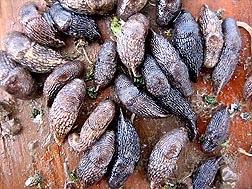This page has been archived and is being provided for reference purposes only. The page is no longer being updated, and therefore, links on the page may be invalid.
| Read the magazine story to find out more. |
|
|
From Bad to Worse: Scientists Confirm Worms Are Eating Slug Bait
By Ann Perry
May 19, 2014
Nocturnal monitoring by U.S. Department of Agriculture (USDA) scientists has confirmed that voracious worms in the Pacific Northwest are behind the disappearance of field pesticides used to control equally voracious slugs. These findings by Agricultural Research Service (ARS) agronomist George Mueller-Warrant and others could help producers better manage their applications of slug bait, an effort that costs around $3.7 million every year. ARS is USDA's chief intramural scientific research agency.
The grey field slug population in the Pacific Northwest is thriving, thanks to no-till management and other practices that enhance soil quality and prevent erosion. So producers apply around 3 million pounds of slug bait—often in the form of iron phosphate pellets or metaldehyde pellets, granules, or liquid—every year.
Mueller-Warrant, who works at the ARS Forage Seed and Cereal Research Unit in Corvallis, Oregon, conducted a study to determine how much and how quickly slug bait was being lost to worms. His team salted 15 grass seed production fields and greenhouses with different types of slug bait and then spent four hours every night observing the foraging behavior of the worms. Averaged over all observations, half of the bait pellets disappeared in less than 2.5 days.
The worms approached bait pellets the same way they approached all other potential food sources, and 20 percent of the time ate it on the spot. But they usually took the pellet back into their burrows, sometimes at the rate of three every hour. The scientists noted that the worms strongly preferred the less-expensive metaldehyde and iron pellets to other forms of the bait.
Oregon producers currently apply around 10 pounds of slug bait per acre two to five times a year to more than 185,000 acres of grass seed fields. But since much of the bait in pellet form is quickly consumed by worms, Mueller-Warrant believes that in fields of high-value crops, it might be more cost-effective to apply the more expensive granular and liquid bait, which the worms typically ignore.
Results from this study were published in Crop Protection in 2012.

